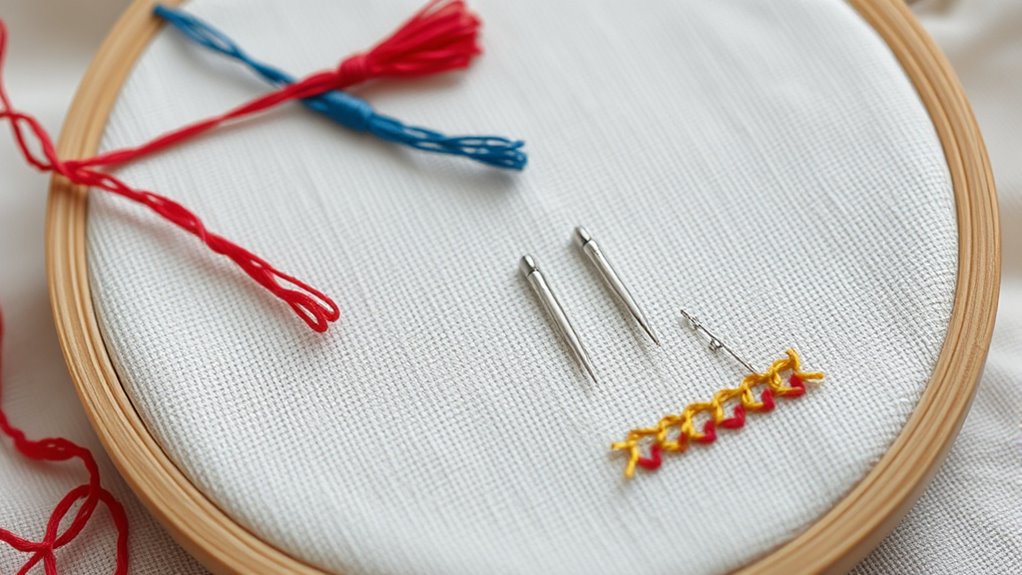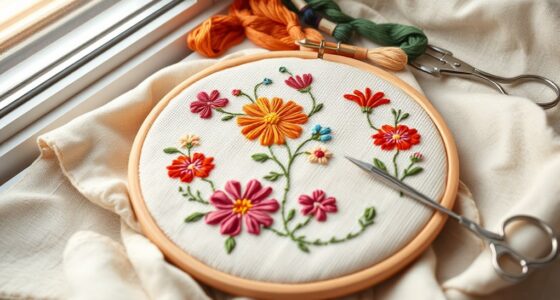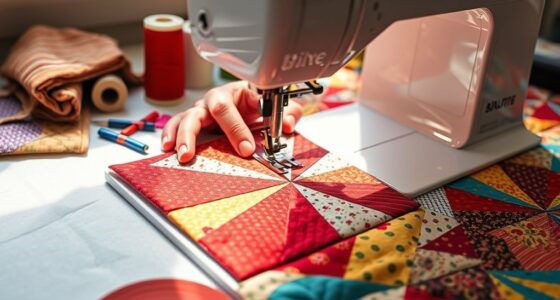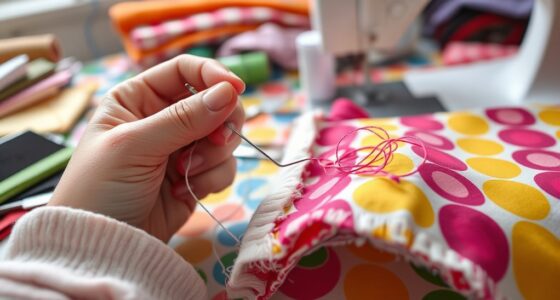To start hand embroidery, gather basic tools like an embroidery hoop, sharp needles, and colorful embroidery threads. Focus on mastering simple stitches such as backstitch, satin stitch, and French knot, which form the foundation of many patterns. Choosing easy-to-work fabrics like cotton or linen helps control your stitches and results. If you keep practicing, you’ll gain the skills needed to create beautiful designs—everything you need to know is just ahead.
Key Takeaways
- Essential tools include embroidery needles, hoops, scissors, and embroidery floss for precise stitching.
- Start with basic stitches like backstitch, satin stitch, and French knot to build foundational skills.
- Choose appropriate fabrics such as cotton or linen for easier handling and better stitch control.
- Proper tension and consistent stitch length ensure neat, professional-looking embroidery.
- Practice simple projects to develop technique, improve control, and gain confidence in hand embroidery.
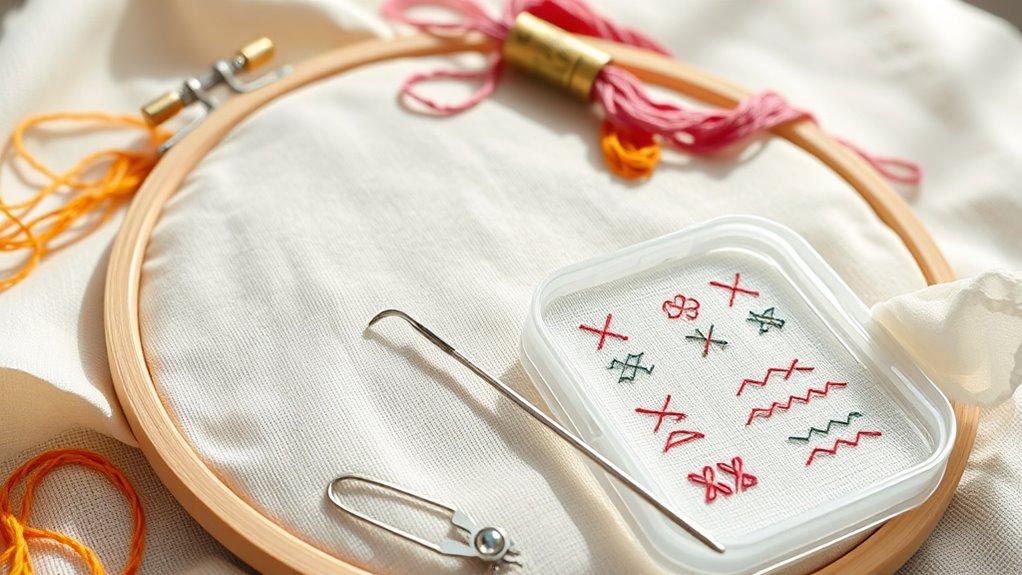
Have you ever wanted to create beautiful, personalized designs on fabric but didn’t know where to start? Embroidery is a fantastic way to add a unique touch to your clothing, accessories, or home decor. To begin, understanding the basics of stitching techniques and fabric selection can make all the difference. Your choice of stitches will influence the look and durability of your embroidery, so it’s essential to learn a few fundamental techniques like the backstitch, satin stitch, and French knot. These stitches are the building blocks for more complex patterns, so mastering them early on will give you confidence and flexibility. When practicing stitching techniques, focus on maintaining even tension in your threads and consistent stitch length. This will ensure your designs look clean and professional. As for fabric selection, opt for materials that are easy to work with, such as cotton, linen, or even a sturdy felt. These fabrics provide a stable surface, making it easier to control your stitches and avoid puckering or uneven tension. If you’re working on a delicate or stretchy fabric, consider stabilizers or interfacing to provide extra support. The right fabric not only makes stitching smoother but also affects how the finished embroidery will look and hold up over time. When choosing your fabric, think about the intended use of your project. For example, if you’re making a decorative pillow, a medium-weight cotton or linen works well because it’s durable and easy to handle. If you’re creating intricate, detailed designs, a plain, tightly woven fabric will allow your stitches to sit neatly and prevent the pattern from puckering. Additionally, keep in mind the color and texture of your fabric, as they can influence the overall aesthetic of your embroidery. Once you’ve selected your fabric, gather the appropriate tools, including embroidery hoops, needles, and thread. Starting with a simple project allows you to experiment with different stitching techniques and get comfortable with handling your materials. To improve your embroidery skills and achieve better results, consider learning about proper fabric stabilization and how it can help produce more professional-looking designs. As you practice, remember that patience is key. The more you work with various fabrics and stitches, the better you’ll become at translating your ideas into beautiful embroidered designs. Whether you’re creating small motifs or large, elaborate patterns, choosing the right fabric and mastering basic stitching techniques will set a strong foundation for your embroidery journey.
Frequently Asked Questions
What Are the Best Beginner-Friendly Embroidery Patterns?
For beginner-friendly embroidery patterns, start with simple floral designs and geometric patterns. These are easy to follow and help you build your skills. Opt for patterns with clear outlines and minimal color changes, making your stitching more manageable. You can find plenty of free or beginner-focused patterns online. Practice regularly, and soon you’ll be creating beautiful embroidered pieces with confidence and precision.
How Do I Choose the Right Embroidery Hoop Size?
Choosing the right embroidery hoop size is like finding the perfect fit for a shoe—comfort and control matter. For delicate fabrics like silk or linen, opt for smaller hoops to avoid damage and guarantee durability. If you’re working on larger projects, bigger hoops give you more space to maneuver. Consider your fabric type and how much tension you need; a sturdy, well-sized hoop keeps your stitches even and your project secure.
Can I Use Any Fabric for Hand Embroidery?
You can use many types of fabric for hand embroidery, but fabric suitability is key. Choose embroidery material selection carefully; cotton, linen, and even silk work well because they offer a stable surface. Avoid stretchy or slippery fabrics, as they make stitching difficult. For best results, pick a fabric that’s easy to work with, matches your project, and provides a smooth, even surface for your stitches.
How Do I Maintain and Store Embroidery Tools?
To keep your embroidery tools in top shape, prioritize tool safety by cleaning and drying them after each use. Store your needles, scissors, and threads in dedicated containers or organizers to prevent damage and loss. Use small boxes or pincushions for easy access. Regularly check for rust or dullness, and keep sharp tools out of reach of children. Proper storage solutions guarantee your tools stay safe, organized, and ready for your next project.
What Are Common Mistakes to Avoid as a Beginner?
As a beginner, you should avoid uneven thread tension and poor fabric selection, which can ruin your stitches. Don’t pull the thread too tight or too loose, and choose fabric that’s suitable for embroidery to prevent puckering. Also, steer clear of rushing your work, which causes mistakes. Take your time, practice basic stitches, and regularly check your tension and fabric choice to improve your skills.
Conclusion
Now that you’ve learned the basics of hand embroidery, you’re ready to bring your ideas to life with colorful stitches and tiny treasures. Think of each stitch as a brushstroke on your canvas, transforming simple fabric into a masterpiece. With patience and practice, your skill will grow, and your projects will tell stories only you can create. So, pick up your needle and let your imagination weave a tapestry of beautiful possibilities.

